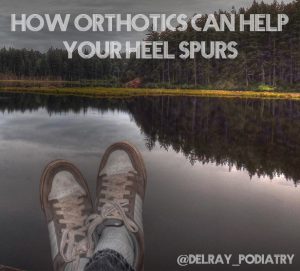A heel spur, also known as a calcaneal spur, develops as an abnormal growth of the heel bone when calcium deposits form a bony protrusion on the underside of the heel — a process that usually occurs over a period of many months.
These spurs are especially common among athletes whose activities include large amounts of running and jumping. Additionally, women have a significantly greater risk for heel spurs due to their typically constraining choices in footwear.
The pain caused by heel spurs is often worst when you first arise in the morning and get to your feet. You may also experience intermittent or chronic pain during physical activates such as walking, jogging, or running if inflammation develops at the point of the spur formation.
Many people describe the pain of heel spurs and plantar fasciitis as a knife or pin sticking into the bottom of their feet when they first stand up in the morning — a pain that later turns into a dull ache.
A few signs that you might be suffering from a heel spur include:
-You can actually feel a small growth of bone around your heel.
-You notice that your heel has come red and swollen.
-You experience pain located in the front portion of your heel.
-You experience a sharp pain in bottom of their feet in the morning that later dulls throughout the day.
-You begin to develop knee, back, hip or ankle pain in conjunction with your heel pain.
How Orthotics Can Help Heel Spurs
At Delray Beach Podiatry, Dr. Ian S. Goldbaum, a podiatric physician and surgeon with over 30 years of experience, has treated countless heel spurs throughout his tenure in medicine. His recommended treatments for heel spurs and associated conditions include, but are not limited to: exercise, custom-made orthotics, anti-inflammatory medications, and cortisone injections.
In the end, more than 90 percent of people get better with nonsurgical treatments. However, if conservative treatment fails to treat symptoms of heel spurs after a period of 9 to 12 months, surgery may be necessary to relieve pain and restore mobility.
When it comes to nonsurgical treatments, Dr. Goldbaum believes that custom-made orthotic inserts are often the best non-invasive route to fixing heel spur-related pain.
Orthotics are orthopedic devices made of lightweight materials that range in complexity from simple shoe inserts bought over-the-counter to intricate custom-made devices crafted specifically to fit your needs.
These orthotics can help restore your ability to walk, run, and jump by reducing pain and swelling while also increasing the stability of unstable joints and providing better arch support. They can also ease problems in other parts of the body, such as the back and hips.
In this case, they’re perfect for alleviating pain caused by heel spurs.
“You want something with shock absorption properties,” said Dr. Goldbaum. “From heel strike all the way through gait, we’re able to offload the areas of pain, taking pressure off the area of the foot that is being aggravated by the spur. We do that with a fabricated orthotic, making an actual plaster cast of your foot to get the perfect fit.”
In some cases, a heat-molded orthotic may be prescribed instead of the plaster casting. This decision is based off Dr. Goldbaum’s diagnosis after having examined X-rays and scans while also taking into account direct patient feedback.
“We don’t do orthotics on a first visit,” said Dr. Goldbaum. “When we do a cast, we typically try some orthopedic padding and strapping first as well as some injectibles. If the pain is still persisting after a couple visits, that’s when we craft an orthotic.”
Once it is decided that an orthotic is right for you, the casting process will take roughly 20-30 minutes with the final product taking anywhere from a few days to three weeks to complete. Unlike their over-the-counter counterparts, these orthotics are built to last and can often be easily adjusted over the years.
“They’re going to last anywhere from 5-20 years if the patient’s foot doesn’t change,” said Dr. Goldbaum, who notes that 98 percent of his patients have been satisfied with their custom orthotics. “We also give our patients the cast so they can craft future orthotics without additional casting fees.”
—
Follow Delray Beach Podiatry on Twitter @Delray_Podiatry
The content on this website is for informational purposes only. Do not rely or act upon information from www.DelrayBeachPodiatry.com without seeking professional medical advice. If you live in South Florida and would like a consultation with Dr. Ian Goldbaum, a podiatric physician and surgeon with over 30 years of experience, please see our contact information below:
BOCA/DELRAY
16244 S. Military Trail #290, Delray Beach, FL 33484
561-499-0033
BOYNTON BEACH
8198 Jog Road #100, Boynton Beach, FL 33472
561-499-0033

No responses yet